The Review of the History of the Shoah
The only European periodical devoted to the history of the destruction of the Jews of Europe, and the first review of history on the subject, this publication is essential for any student or researcher working on this caesura of history. She intends to give an overview of the current projects in the historiography of Judeocide.
The Revue d'histoire de la Shoah also opens its field of study to other tragedies of the century: the genocide of the Tutsi in Rwanda, that of the Armenians of the Ottoman Empire and the massacre of the Gypsies.
The RHS is freely accessible online on Cairn.info for issues published between 2005 and 2016
FIND OUT MORE CALL FOR CONTRIBUTIONS FOR THE N°223
Objects. New perspectives on the material history of the Holocaust
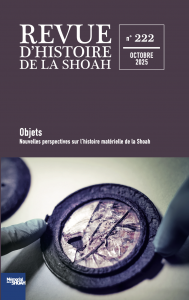 (Review of the History of the Shoah, No. 222, ed Memorial of the Shoah, October 2025)
(Review of the History of the Shoah, No. 222, ed Memorial of the Shoah, October 2025)
under the direction of Ania Szczepanska
With the notion of spoliation (and return) has been raised for decades the question of objects in the Shoah, focused on works of art and valuable movable property (paintings, musical instruments, furniture, etc.).
But what about the other material traces, objects considered as "worthless"? Objects "of everyday life"? 'Personal effects'?
This issue seeks to define these humble objects, to identify their specific characteristics and to place them in a multidisciplinary reflection: how archaeology, literary or cinematographic studies, art history, law and many other fields of research confront these objects? And how, beyond that, do they give the keys to their apprehension through museums, memorial centers, conservation laboratories, etc.
Traces of life "before", testimonies of the war, spoliations and deportation, bases of writing history and work of memory, these objects are all that. Addressing them involves a three-pronged approach: defining the nature, provenance and specific context of these objects; reconstructing their life since the war and their narrative development; determining their current use and circulation through the prism of museum collections. It is to this reflection, informed by the experience and questioning of specialists from various disciplines, that this issue of the Revue d'histoire de la Shoah invites.
Distortions of the Shoah and new denialism
 (Review of the History of the Shoah, No. 221, ed Memorial of the Shoah, March 2025)
(Review of the History of the Shoah, No. 221, ed Memorial of the Shoah, March 2025)
under the supervision of Jean-Marc Dreyfus and Audrey Kichelewski
While the pervasiveness of the frontal negationism of the genocide of the Jewry of Europe seems to have diminished in recent years, new forms of falsification, more blurred, more diverse, more difficult to describe even, are emerging across Europe and the world. The terminology designating these discourses is itself uncertain: revisionism, deviations, utilitarianism, trivialization, etc.? The English expression Holocaust distortion ("deformation" of the Shoah) is gaining popularity and largely describes the negation of national responsibilities in the Shoah: from Poland to Bulgaria, from Ukraine to the United States, in France itself, examples are multiplying, with so many political particularities.
If in some countries, these distortions are carried by a fringe of the academic milieu, these new negationisms are largely the result of personalities and political parties from the radical right, from Benjamin Netanyahou to Marine Le Pen, from Viktor Orban to the PIS. Furthermore, the internet and social networks amplify these discourses and blur the distinction between a politicized public history and a critical history of sources. This issue analyzes in detail these new forms of historical narratives in several countries, including the United States and Israel – and describes these same strategies for distorting the history and memory of the Armenian genocide and that of the Tutsi.
Varia
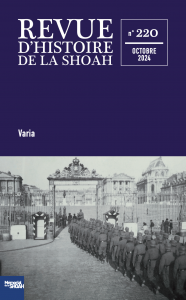 (Review of the History of the Shoah, No. 220, ed Memorial of the Shoah, October 2024)
(Review of the History of the Shoah, No. 220, ed Memorial of the Shoah, October 2024)
under the supervision of Jean-Marc Dreyfus and Audrey Kichelewski
This issue of the Revue d'histoire de la Shoah brings together articles that address various themes. The more open than usual approach proposed by this issue is intended to respond to the curiosity of readers and show the liveliness of current work on the Holocaust.
These studies mainly focus on France and question for the first time the role of major French institutions in the persecution of the Jews (the Palace of Versailles, the Palais de Tokyo, the Red Cross), but also the prism of the distance between Paris and the provinces (the city of Bordeaux and the department of Cher).
The destruction of the Jews, the different faces of plunder, the failure of some and the greed of others... , all these subjects emerge through particular cases as well as in their collective dimension.
Their nationality, their experience and their background, their fields of study and their institutions of affiliation allow historians and art historians who sign these texts to highlight both the French and European dimension of this research in perpetual movement.
Luxembourg and the Shoah. Spoliations, deportations, memory.
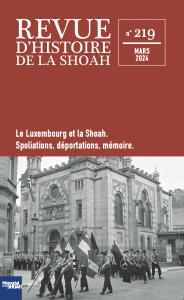 (Review of the History of the Shoah, No. 219, ed Memorial of the Shoah, March 2024)
(Review of the History of the Shoah, No. 219, ed Memorial of the Shoah, March 2024)
under the direction of Blandine Landau and Atinati Mamatsashvilii
Territory hitherto little explored by research on the Holocaust, the Grand Duchy of Luxembourg is a country whose status during the Second World War and the relationship with its Jewish minority are very particular. At the crossroads of France, Belgium and Germany, nearly five thousand Jews lived there before the German invasion on May 10, 1940, and less than a thousand returned after the war.
Refuge for many exiles from Germany and Austria during the 1930s, the country is invaded on May 10, 1940. On August 2, a civil administration is set up under the authority of Gustav Simon, in order to prepare for the annexation of the territory to the Reich. Anxious to encourage the support of the population, Simon ensures the promotion of Volksgemeinschaft and the exclusion of other populations, starting with the Jews. These are pushed to the start or deported, their property confiscated and aryanized. In June 1943, the seventh and last deportation convoy leaves Luxembourg-city. In the aftermath of the war, while the memory of the genocide is being built throughout Europe, nothing is undertaken in Luxembourg where no public monument evokes the persecution of the Jews. The turning point of 2015 and the apology made by the state to the Jewish community are giving new impetus to this aspect.
This issue explores the complex workings of these multiple processes, rigorously organized by the Nazi administrative machine. In the light of the latest research, the modalities of exclusion and dispossession, the structures of concentration of the Jewish population and its deportation, as well as the difficult return of survivors and the development of a memorial policy, emerge.
Vatican, Church and the Shoah. Historiographical renewal around the Pius XII archives
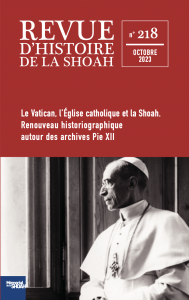
(Review of the History of the Shoah, No. 218, ed Memorial of the Shoah, October 2023)
Under the direction of Nina Valbousquet
At the time when a major archival project is opening with the Vatican archives for the pontificate of Pius XII (1939-1958), the Revue d'Histoire de la Shoah intends to make a historiographic assessment and explore new avenues of research around the controversial question of the attitude of the Vatican and the Church towards the Holocaust.
On 4 March 2019, Pope Francis announced the declassification of the Vatican archives relating to the pontificate of Pius XII, affirming his "trust" in "serious and objective historical research". A year later, on March 2, 2020, the Vatican effectively makes these unpublished documents accessible to the scientific public: a historical opening due to the breadth of documentary resources and the exceptional nature of the archival process, but also because it is a discussed pontificate and a period of great political and religious changes, from the outbreak of the Second World War to the beginnings of the Vatican II council.
Old controversies (about the Vatican’s attitude to the persecution of the Jews and to Nazism) were immediately revived. These memorial debates and this polarized history, between condemnation and apology, partly date back to the controversies of the 1960s around the German play by Rolf Hochhuth Le Vicaire (1963), accusing Pius XII of silent complicity in the genocide of the Jews.
This vast subject has often been approached from a theological and moral point of view. But the present file also takes into account political, diplomatic, international and humanitarian issues by questioning the capacity for reaction and action of an institution both spiritual and temporal as well as its limits in the face of extreme violence and genocide.
To the question of the pope’s silences is added that of the "dilemmas" of the ecclesiastical hierarchy in a context of crisis: political, diplomatic, humanitarian and theological dilemmas, between charity and neutrality. The complexity of these choices and the motivations underlying them are now more clearly visible, intersecting with other themes such as humanitarian assistance, the refugee crisis before, during and after the war, relations with fascism and democracy, anticommunism, the protection of former Nazis and fascists in the post-war period, the position of the Vatican against the justice of the Allies and the immediate memory of the Shoah in Christian conscience.
Indeed, while the polemics focus on the personality of Pius XII, the new archives and their cross-referencing with other documentary resources allow us to grasp the diversity of the Catholic world and "the sociological complexity of the Churches".
If the question of the Vatican constitutes the red thread of this file, the articles address broader themes and report on historiographical reflection and research through field investigations and case studies.
Persecution of the Roma and Sinti and genocidal violence in Western Europe, 1939-1946
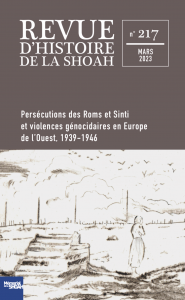
(Review of the History of the Shoah, No. 217, ed Memorial of the Shoah, March 2023)
Under the direction of Ilsen About
During the Second World War, the Roma and Sinti were the target of multiple persecutions and genocidal violence whose chronology and intensity vary according to the territories of Europe. These persecutions have also concerned Manouches and Gypsies, as well as groups associated by history with the anti-Gypsyism measures and designated by their profession or their supposed way of life, such as the Yéniches, the basket-makers, fairmen, Circassians and travelers.
The often deliberate concealment and late recognition of these persecutions contributed to the marginalization of facts that led to the physical elimination of more than 200,000 people throughout Europe and the irreversible dislocation of pre-war Romani societies. Even if many shadows remain, the different chapters of this story now appear very clearly.
This issue of the Revue d'histoire de la Shoah covers several countries in western Europe. There, the composite nature of the repressive tools translates into a large plurality of devices following the variable application of antigypsy measures: house arrests, detentions, internments, concentrations, targeted or random executions, deportations to killing centers or the concentration network. The diversity of the logics at work, the distinct modalities of violence and their effects on the targeted collectives are here enlightened. The writing of this multiple history, through the exploration of new archives, the study of individual and collective destinies, as well as the memory of facts are at the heart of these studies, and of a research still in progress.
New research on the Holocaust and the post-Shoah in Poland

(Revue d'histoire de la Shoah, n°216, ed. Mémorial de la Shoah, October 2022)
Entitled "New research on the Shoah in Poland", this file gathers contributions concerning innovative approaches, as well as terms from new sources mobilized as from approaches. The sources and stories of the Jewish victims and survivors are mobilized in their cross-referencing with official and clandestine documents of the time. The pioneering writings of surviving historians of the Holocaust, such as Nachman Blumental, director of the Institute of Jewish History in Warsaw until 1949, are rediscovered and appreciated for their early clairvoyance.
The micro-historical approach highlights the local diversity of situations, while revealing comparable mechanisms in the persecution and (low) survival of Jews in the most well-known cities (Warsaw, Lodz) or more modest (Tarnow). Taking into account the materiality – those of the bodies after gassing in killing centers like Belzec or Sobibor, but also that of the waste accumulated in the ghettos – offers additional keys to understanding the daily lives of these tracked men, women and children, locked up or hidden, and most often destroyed in immense sufferings.
Finally, the story of the extermination of the Jews in Poland deserves to be placed back in the long term, allowing us to see not only the rhetorical and effective dynamics of exclusion at work in Poland between-two wars but also the very long shadow of the Shoah between after the war and until today. This issue is all the more essential at a time when distorted discourses on the history of the Second World War and on the Holocaust are flourishing in Europe, aiming to question irrefutable and consensual achievements of historical science in favor of a narrative more comfortable for societies, but dishonest and capable of legitimizing even the most violent political actions.
The Jewish cemetery in the Shoah
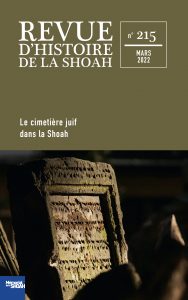
(Review of the History of the Shoah, No. 215, Memorial of the Shoah edition, March 2022)
Under the direction of Jean-Marc Dreyfus and Judith Lyon-Caen
What happened to the Jewish cemeteries, some recent, others immemorial, in the persecution and the Shoah? Singular peri-urban or rural landscapes, they were, like all Jewish institutions, disrupted in Germany from 1933 and then throughout the war. Suicides and deportations can be read there. Sometimes they disappeared and were desecrated, while the bodies were transferred to mass graves. Yet, most of the Jewish cemeteries in Germany and Europe were not destroyed by the Nazis.
During the war, the Jewish cemetery was a space of passage, of transit in the heart of the hostile city (like the Jewish cemetery in Warsaw, adjacent to the ghetto); it served to gather the Jews and give them refuge, when all other places were forbidden to them; it was the ultimate repository for the bodies of victims (Jewish or not) to whom any human funeral treatment was refused, resulting in the opening of mass graves; it also offered a framework for executions.
After the Shoah, abandoned cemeteries, deprived of their "natural" deaths, remained places of witness to the Jewish catastrophe, despite movements for re-burial – surviving parents searching for the bodies of the disappeared to return them to the Jewish cemetery. The absence of graves is matched by the construction of thousands of memorials in the very cemeteries, dedicated to those who died in the camps, in hiding.
A place of meditation, a place to think about the death of the disappeared from the Shoah, the Jewish cemetery is also the place of traces of years of persecution, those engraved on the headstones of premature deaths, those that form empty spaces, waiting for the dead who never came...
Trying war criminals in eastern Europe (1943-1991)
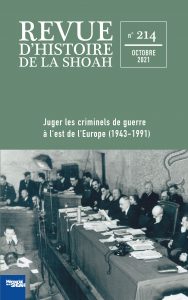
(Revue d'histoire de la Shoah, n°214, ed. Mémorial de la Shoah, octobre 2021)
Under the direction of Audrey Kichelewski and Vanessa Voisin
This new issue of the Revue d'histoire de la Shoah looks at the question of the fate of war criminals, which has been the subject of intense controversies between Allies since 1942. Highly political from its beginnings, the debate has nevertheless led to innovations in international law, adapted by most states in their criminal law.
The purpose of this dossier is to present the most recent research on the trials of war criminals in Central Europe and the Soviet Union. Less well-known and often accused of political exploitation, these war crimes trials have nevertheless contributed to shaping the representations of the Second World War and the Holocaust. Their modalities and their impact therefore make sense: did they take into consideration, deliberately or incidentally, the description of the fate of the Jews and the singularity of the Holocaust? Their sociocultural, symbolic, memorial and transnational dimensions are here analyzed in the light of the circulations between East and West as well as within the Eastern bloc, but also in the light of the practices and imaginaries of justice.
These crimes that go beyond border logics and classical criminal categories, even the very context of the cold war, also invite to think about these trials, the controversies they have raised and the European judicial systems in their operation towards war criminals beyond strictly national frameworks and issues.
New approaches to the Holocaust in the Soviet Union
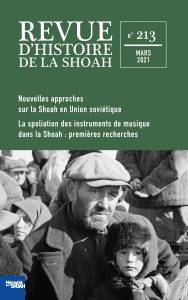
Under the direction of Jean-Marc Dreyfus
The plunder of musical instruments in the Shoah: first research
Under the direction of Claire Andrieu and Jean-Marc Dreyfus
(Review of the History of the Shoah, No. 213, ed. Memorial of the Shoah, March 2020)
The Holocaust in the USSR.
Up to 1.3 million Jewish Soviet citizens were murdered during the war. Recent historiography has allowed considerable advances, describing the great diversity of killing methods, from massacres in pits to gas trucks. The vision of an organized and methodical genocide carried out by Einsatzgruppen is followed by that of a multitude of massacres perpetrated by police units and military forces assisted by Ukrainian or Baltic auxiliaries. This new vision is reinforced by the perception of a much broader temporality and spatiality: the killings took place over months, even years, and on an immense territory that has not finished delivering its mass graves.
Theft and restitution of musical instruments.
The Nazi organizations in charge of looting paid specific attention to musical instruments, both ancient and prestigious as well as familiar and banal. Because classical music, and particularly German music, was at the heart of the staging of the Nazi regime. Within the great organization for the plundering of cultural property, a "musical kommando" had been created, which gathered the most precious instruments, but also the ancient scores and treatises of musicology, many very rare. Hundreds of thousands of musical instruments, stolen throughout Europe, were distributed to the German population and to the museums of the Reich. Charged with a strong emotional dimension, these instruments were little returned after the Holocaust. This dossier on the spoliation of musical instruments is the very first one on this subject and sets valuable milestones for future research.
«Vichy, the French and the Shoah – A state of scientific knowledge»
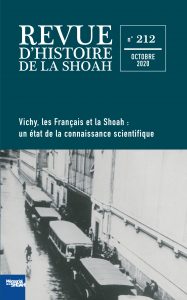 (Review of the History of the Shoah, No. 212, ed. Memorial of the Shoah, October 2020)
(Review of the History of the Shoah, No. 212, ed. Memorial of the Shoah, October 2020)
under the direction of Laurent Joly (CNRS)
For its second issue emanating from the new editorial committee led by Audrey Kichelewski and Jean-Marc Dreyfus, RHS – Revue d'histoire de la Shoah, the oldest scientific journal on the subject, testifies to the vitality and richness of international research on the Shoah.
In 1945, faced with the purge, the leaders of Vichy, Pétain and Laval the first, had thus justified their policy against the Jews: Vichy avoided to the Jews of France the fate of the Jews of Poland; its policy was guided by the desire to protect the French Jews, even if it means sacrificing foreign Jews to change; and it is thanks to this policy that the majority of Jews have survived in France...
TELL ABOUT THE HOLOCAUST – 40 YEARS OF PERSONAL WRITINGS IN THE JEWISH WORLD

(Review of the History of the Shoah, No. 211, ed. Memorial of the Shoah, March 2020)
This 211th issue is devoted to all the writings published between 1946 and the mid-1980s. In the four decades after the war, the editors of Le Monde Juif mobilized their national and international networks to publish a wide range of personal writings. These first-person accounts evoked documented aspects of the persecution or extermination of the Jews, far beyond France. Sometimes they came in support of historical records; or they accompanied major commemorative events. Excerpts from books published abroad also appear in the journal: thus the reader comes across Jan Karski, Primo Levi or Leib Rochman. But very diverse in their style and authors, these personal stories are also often one of the only traces that we keep of these witnesses, to whom this number pays tribute by giving to read their writings.
The intellectual roots of Mein Kampf
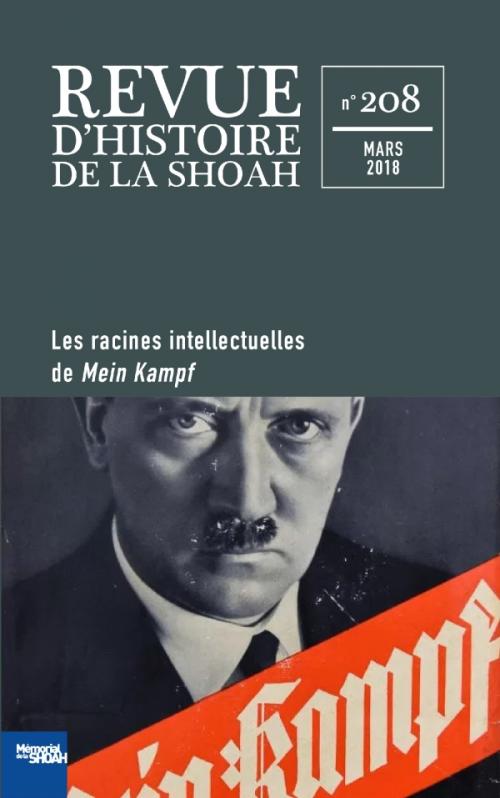 (Review of the History of the Shoah, No. 208, ed. Memorial of the Shoah, March 2018)
(Review of the History of the Shoah, No. 208, ed. Memorial of the Shoah, March 2018)
The subject of this issue is the analysis of the multiple sources used by Hitler to write Mein Kampf, whose first volume was published in 1925. Where do his main ideas come from? What were the milestones in his ideological formation? What texts did Hitler read in Vienna before 1913 and in Munich after 1919? Which authors, in particular, obviously nourished his thought? What are, among them, the major, overrated or secondary sources of inspiration? If we know today that Mein Kampf is in no way an original work and that this text amalgam, often in a confused way, many ideas spread at the time, it is still necessary to list these influences. Their common denominator is antisemitism.
Philosophers facing the Holocaust
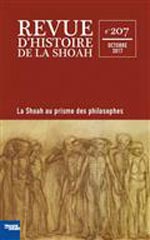 (Review of the History of the Shoah, No. 207, ed. Memorial of the Shoah, October 2017)
(Review of the History of the Shoah, No. 207, ed. Memorial of the Shoah, October 2017)
This issue proposes to offer a picture of the contribution of philosophers to reflections on the Shoah, of which it strives to present various sides. Although the majority of the philosophers summoned were contemporary with the Third Reich and Nazism, an abyss often separates them. There are those who, from near or far, were victims (Jean Améry, Hannah Arendt), those who saw "nothing" (Paul Ricoeur), those who acclaimed the Reich and the "destruction of the Jews of Europe" (Heidegger), contributing to make philosophy sink with them.
Italy and the Holocaust. Representations, political uses and memory
 (Shoah History Review, No. 206, Memorial of the Shoah edition, March 2017)
(Shoah History Review, No. 206, Memorial of the Shoah edition, March 2017)
Despite the racial laws of 1938 and its collaboration with the Reich, fascist Italy did not participate directly in the deportation of the Jews from the peninsula before September 1943. Many Italian Jews were protected and, compared to neighboring Yugoslavia, the Holocaust in Italy was among the least deadly in Europe. Today, the memory of genocide occupies an important place: publications, colloquiums, history centers are multiplying. The Italian visitors to Auschwitz constitute numerically the third largest group. This second issue of our diptych questions the meanders of a memory of genocide that has become a question of history.
The Jews of the East facing Nazism and the Holocaust (1930-1945)
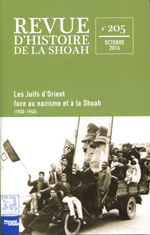 (N°205, October 2016)
(N°205, October 2016)
In partnership with the Ben Zvi Institute, Jerusalem, Israel
The Jewish communities scattered from Morocco to Iraq, from Egypt to Yemen, are well informed of the vicissitudes of a European Judaism which is then by far the majority. From the advent of the Nazis in power, they organized with more or less success the boycott of German products, at the risk of cutting themselves off from local authorities as well as Arab nationalist movements. But this solidarity quickly tests its limits, especially when war breaks out in Europe. For the Jewish communities of the Arab world, Nazism and the war constitute a major turning point. In 1945, their future in their homeland seems less assured than ever.
RHS SUBSCRIPTION BULLETIN














 (Review of the History of the Shoah, No. 207, ed. Memorial of the Shoah, October 2017)
(Review of the History of the Shoah, No. 207, ed. Memorial of the Shoah, October 2017) (Shoah History Review, No. 206, Memorial of the Shoah edition, March 2017)
(Shoah History Review, No. 206, Memorial of the Shoah edition, March 2017) (N°205, October 2016)
(N°205, October 2016)